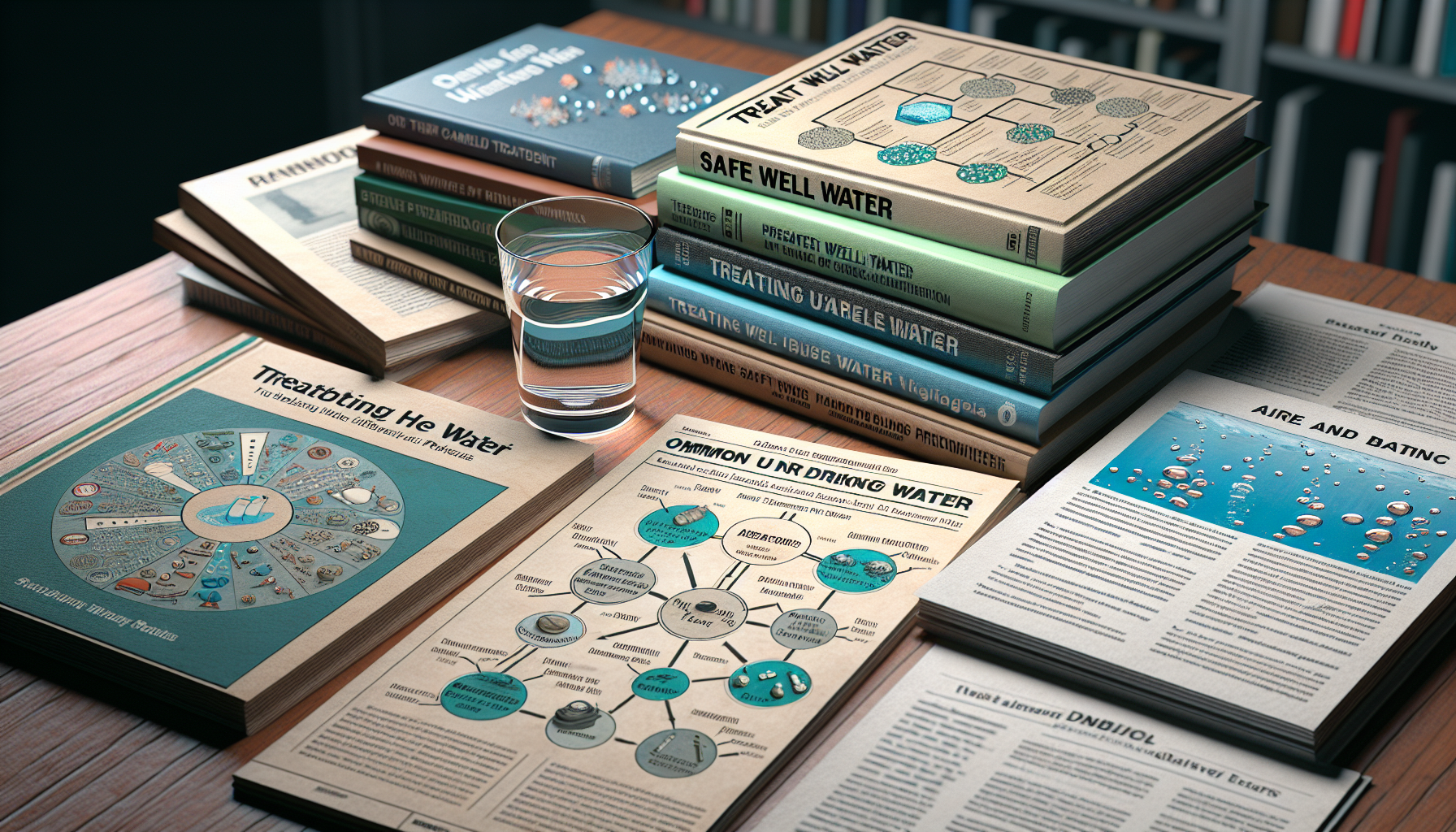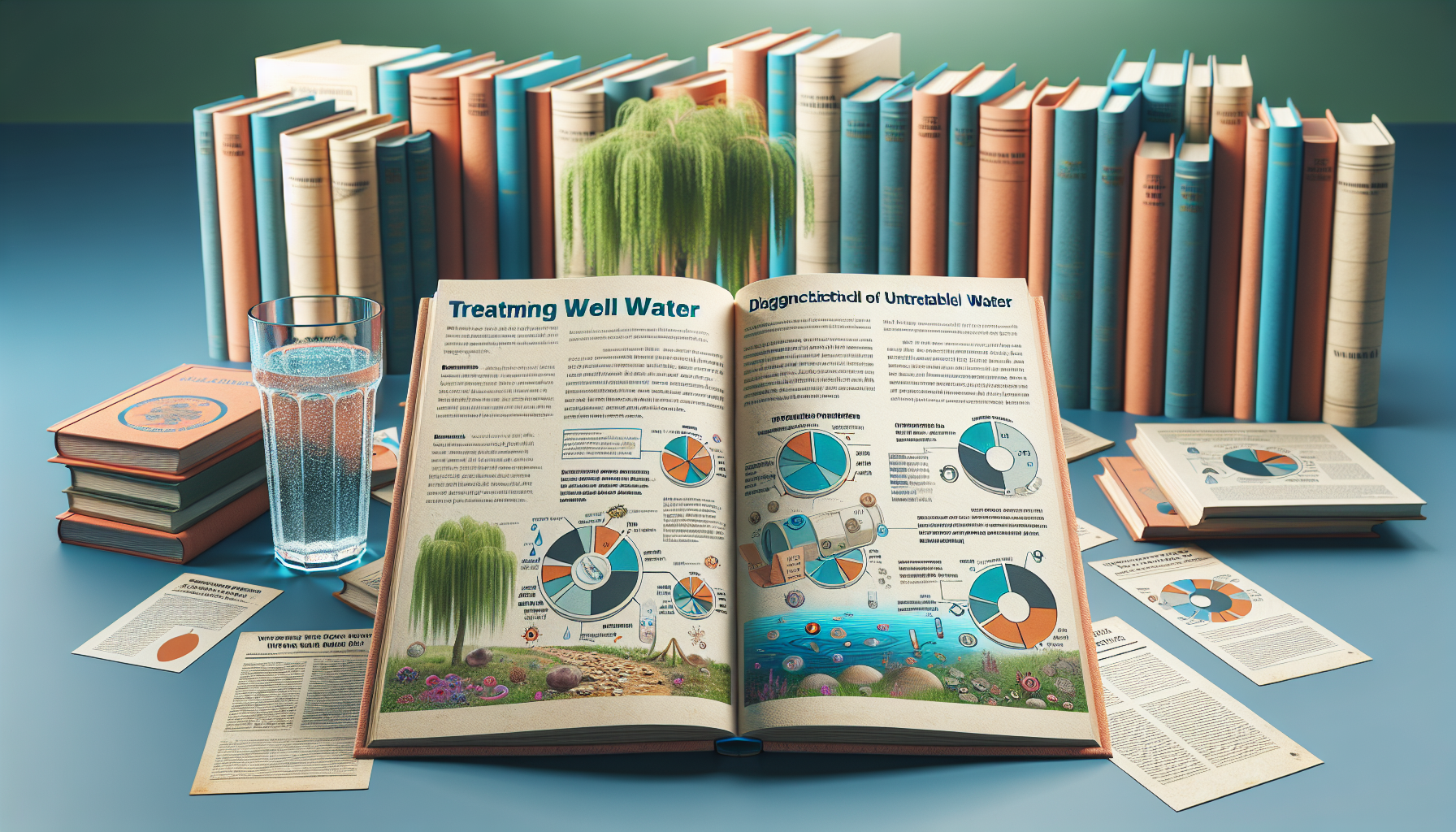If you’re seeking reliable and practical information on treating common waterborne pathogens in well water, you may find yourself wondering which publications can offer valuable guidance. Understanding the best practices for well water treatment is crucial for ensuring the safety and purity of the water you consume. Thankfully, there are numerous publications available that specialize in providing comprehensive advice on this matter. By exploring these publications, you can gain valuable insights on effective treatment methods and the necessary steps to ensure your well water remains free from harmful pathogens.
1. Centers for Disease Control and Prevention (CDC)
The Centers for Disease Control and Prevention (CDC) is a renowned authority in the field of public health and disease control. When it comes to well water treatment for common waterborne pathogens, the CDC offers valuable resources and guidelines to ensure the safety of your drinking water.
1.1. Waterborne Disease Prevention
The CDC recognizes the importance of preventing waterborne diseases through proper well water treatment. They provide extensive information on the different types of waterborne diseases, their symptoms, and the potential sources of contamination. Additionally, the CDC offers guidance on maintaining well integrity, regular testing, and disinfection practices to minimize the risk of waterborne diseases.
1.2. Well Water Testing and Treatment
To ensure the safety of your well water, the CDC emphasizes the significance of regular testing and treatment. They recommend testing your well water at least once a year to identify any potential contaminants. In cases where contamination is detected, the CDC provides guidelines on appropriate treatment methods and technologies to remove or neutralize these contaminants. Their recommendations are based on scientific research and established best practices.
1.3. Common Waterborne Pathogens and their Treatment
The CDC recognizes several common waterborne pathogens that can pose a threat to public health. They provide detailed information on each of these pathogens, including their characteristics, associated diseases, and recommended treatment techniques. From bacteria such as E. coli and Salmonella to protozoan parasites like Cryptosporidium, the CDC offers guidance on the most effective ways to treat and eliminate these pathogens from well water.
2. Environmental Protection Agency (EPA)
The Environmental Protection Agency (EPA) plays a crucial role in safeguarding the environment and public health. When it comes to well water treatment for common waterborne pathogens, the EPA provides valuable information and resources to help individuals make informed decisions.
2.1. Well Water Contaminants
The EPA recognizes the wide range of contaminants that can be found in well water. They offer comprehensive lists and descriptions of these contaminants, including bacteria, viruses, chemicals, and heavy metals. By understanding the potential contaminants that can affect your well water, you can take appropriate steps to test and treat your water accordingly.
2.2. Well Water Treatment Methods
The EPA evaluates and approves various treatment methods for well water. They provide information on different approaches, such as disinfection techniques, filtration systems, and chemical treatments. The EPA’s guidelines help individuals identify the most suitable treatment method based on the specific contaminants present in their well water. By following their recommendations, you can effectively remove or reduce the concentration of harmful pathogens in your well water.
2.3. Recommended Water Treatment Devices for Well Water
The EPA recognizes the importance of using certified and reliable water treatment devices for well water. They maintain a list of approved devices that have undergone rigorous testing and meet the necessary performance criteria. By referring to the EPA’s recommended list, you can make informed decisions when selecting water treatment devices for your well. These devices are designed to effectively remove common waterborne pathogens, providing you with safe and clean drinking water.

3. World Health Organization (WHO)
The World Health Organization (WHO) is a global authority on public health issues, including waterborne diseases and well water treatment. Their guidance and research provide invaluable insights into mitigating the risks associated with waterborne pathogens in well water.
3.1. Water Treatment Guidelines
The WHO has developed comprehensive guidelines on water treatment, which include specific recommendations for well water. They outline the various treatment technologies and techniques suitable for removing different types of waterborne pathogens. These guidelines are widely respected and followed by health organizations worldwide, ensuring that well owners have access to reliable and effective treatment methods.
3.2. Well Water Contamination and Health Risks
Recognizing the potential health risks associated with well water contamination, the WHO provides extensive resources on the topic. They highlight the different sources of contamination, including agricultural runoff, industrial pollutants, and improper well construction. By understanding the potential sources of contamination, individuals can take appropriate measures to prevent and treat well water contamination effectively.
3.3. Pathogen-Specific Treatment Techniques
The WHO acknowledges that different waterborne pathogens require specific treatment techniques for effective removal. They offer detailed guidance on the treatment methods suitable for specific pathogens, such as bacteria, viruses, and protozoan parasites. This pathogen-specific approach ensures that well owners can select the most appropriate treatment technique based on the specific pathogens present in their well water, enhancing the overall effectiveness of treatment.
4. National Ground Water Association (NGWA)
The National Ground Water Association (NGWA) is an organization dedicated to promoting the responsible use and protection of groundwater resources. They provide valuable guidance on various aspects of well water treatment and maintenance to ensure the quality and safety of well water.
4.1. Well Owner’s Guides
The NGWA offers comprehensive guides specifically designed for well owners. These guides provide step-by-step instructions on measures to take for maintaining well integrity and safeguarding against contamination. They emphasize regular well inspections, proper well construction, and appropriate well maintenance practices. By following these guides, well owners can mitigate the risks associated with waterborne pathogens and ensure the longevity of their wells.
4.2. Waterborne Pathogen Testing and Treatment
The NGWA recognizes the importance of testing well water for waterborne pathogens and offers guidance on effective testing methods. They also provide recommendations for suitable treatment techniques based on the specific contaminants found in well water. Their resources help well owners select the most appropriate testing and treatment methods, ensuring the quality and safety of their well water.
4.3. Best Practices for Well Maintenance and Disinfection
To minimize the risk of waterborne pathogens in well water, the NGWA promotes best practices for well maintenance and disinfection. Their resources outline the importance of regular well cleaning, disinfection procedures, and the use of appropriate disinfectants. By following their recommendations, well owners can maintain clean and safe well water, free from common waterborne pathogens.

5. American Ground Water Trust (AGWT)
The American Ground Water Trust (AGWT) is an organization focused on educating the public about the importance of groundwater resources. They provide resources and guidance specifically tailored to well water treatment, addressing the challenges posed by waterborne pathogens.
5.1. Educational Resources on Well Water Treatment
The AGWT offers educational resources to enhance public knowledge about well water treatment. Their resources cover a wide range of topics, including the identification of common waterborne pathogens, suitable treatment methods, and technologies for well water. By utilizing these educational resources, individuals can make informed decisions regarding well water treatment, ensuring the safety and quality of their drinking water.
5.2. Pathogen Removal Techniques for Well Water
Recognizing the need for effective pathogen removal techniques, the AGWT provides guidance on the most appropriate methods. Their resources highlight various treatment techniques, such as ultraviolet (UV) disinfection, reverse osmosis, and activated carbon filtration. By understanding the advantages and limitations of each technique, well owners can select the most suitable method for their specific needs, ensuring the removal of waterborne pathogens effectively.
5.3. Case Studies on Well Water Treatment
The AGWT shares case studies that showcase successful well water treatment initiatives. These case studies demonstrate real-world examples of overcoming challenges associated with waterborne pathogens in well water. By studying these cases, individuals can gain valuable insights into effective treatment strategies and learn from previous experiences, enhancing the success of their own well water treatment endeavors.
6. Water Quality Association (WQA)
The Water Quality Association (WQA) is an industry organization focused on improving the quality of water through treatment and filtration. They provide valuable information and resources related to well water treatment and the removal of common waterborne pathogens.
6.1. Well Water Treatment Solutions
The WQA offers a wealth of information on different treatment solutions suitable for well water. Their resources cover a wide range of technologies and techniques, including ion exchange, chemical disinfection, and various filtration methods. By understanding the advantages and limitations of each solution, well owners can select the most appropriate treatment method to address the specific waterborne pathogens present in their well water.
6.2. Certified Products for Pathogen Removal
To ensure the effectiveness of well water treatment, the WQA certifies products specifically designed for pathogen removal. These certified products undergo rigorous testing to meet the highest standards of performance. By choosing WQA-certified products, well owners can have confidence in the efficacy of their chosen treatment solutions, ensuring the removal of common waterborne pathogens from their well water.
6.3. Water Quality Research and Publications
The WQA actively conducts and promotes water quality research. They publish valuable resources and research findings related to well water treatment and the removal of waterborne pathogens. Their publications cover topics such as treatment efficiency, emerging technologies, and best practices. By referring to their research and publications, well owners can stay updated on the latest advancements and recommendations in well water treatment, optimizing the safety and quality of their drinking water.

7. Journal of Water and Health
The Journal of Water and Health is a reputable scientific publication focused on the field of water quality and health. Their research articles provide valuable insights and guidance on well water treatment for common waterborne pathogens.
7.1. Research Articles on Well Water Treatment
The Journal of Water and Health publishes research articles specifically dedicated to well water treatment. These articles cover a wide range of topics, including treatment techniques, pathogen removal efficiencies, and the impact of well maintenance practices on water quality. By referring to these research articles, you can access the latest scientific knowledge and evidence-based practices for effective well water treatment.
7.2. Studies on Waterborne Pathogens
Recognizing the importance of studying waterborne pathogens, the Journal of Water and Health features studies focused on identifying and understanding these pathogens. These studies explore their characteristics, transmission routes, and potential health risks. By staying informed about the latest research on waterborne pathogens, you can better understand the unique challenges they pose and take appropriate measures to treat and prevent their presence in well water.
7.3. Treatment Technologies for Contaminated Well Water
The Journal of Water and Health publishes articles that assess and evaluate different treatment technologies for contaminated well water. These articles provide insights into the effectiveness of various treatment methods, helping individuals choose the most suitable technology based on the specific waterborne pathogens present in their well water. By considering the findings and recommendations presented in these articles, you can make informed decisions regarding well water treatment, maximizing the removal of contaminants and ensuring the safety of your drinking water.
8. Environmental Science and Pollution Research
Environmental Science and Pollution Research is a scientific journal that covers various topics related to environmental pollution and its impact on human health. Their publications offer valuable information on well water treatment strategies for combating waterborne pathogens.
8.1. Well Water Contamination Studies
Environmental Science and Pollution Research features studies that focus on well water contamination. These studies analyze the sources of contamination, identify potential risks associated with waterborne pathogens, and assess the impact on human health. By studying these articles, you can gain a better understanding of the specific factors that contribute to well water contamination and the necessary treatment strategies to address them.
8.2. Assessing and Mitigating Waterborne Pathogens
The journal publishes research articles that assess and evaluate different mitigation strategies for waterborne pathogens in well water. These articles explore the effectiveness of various treatment methods, disinfection techniques, and consistent monitoring practices. By referring to these publications, well owners can gain insights into the best approaches to mitigate the presence of waterborne pathogens, ensuring clean and safe well water for consumption.
8.3. Review Articles on Well Water Treatment Strategies
Environmental Science and Pollution Research also publishes review articles that summarize the current state of knowledge and research on well water treatment strategies. These articles provide comprehensive overviews of different treatment methods, technologies, and their effectiveness in removing waterborne pathogens. By referring to these review articles, individuals can access a condensed and reliable summary of the available well water treatment strategies, enabling them to make informed decisions about which strategies are most effective for their specific needs.

9. Water Research
Water Research is a reputable scientific journal that focuses on water quality issues, including well water treatment. Their publications offer valuable insights and research findings on the microbial contamination of well water and novel approaches to removing waterborne pathogens.
9.1. Well Water Microbial Contamination
Water Research features research articles dedicated to studying microbial contamination in well water. These articles explore the factors contributing to contamination, the prevalence of microbial pathogens, and their potential health risks. By referring to these articles, individuals can gain a deeper understanding of the microbial contamination challenges in well water and make informed decisions on appropriate treatment strategies.
9.2. Novel Approaches to Waterborne Pathogen Removal
The journal publishes research that focuses on novel approaches for removing waterborne pathogens in well water. These studies explore emerging technologies, innovative treatment methods, and interdisciplinary approaches in the field of water quality and treatment. By staying updated on these novel approaches, well owners can access cutting-edge strategies to effectively remove waterborne pathogens and maintain the safety and quality of their well water.
9.3. Evaluating Treatment Efficiency for Well Water
Water Research publishes research articles that evaluate the treatment efficiency of different methods for well water. These articles assess the effectiveness of treatment techniques in removing waterborne pathogens and reducing their concentration in well water. By considering the findings presented in these articles, individuals can select the most efficient treatment methods to ensure the removal of waterborne pathogens from their well water.
10. Journal of Water Supply: Research and Technology – Aqua
The Journal of Water Supply: Research and Technology – Aqua is a peer-reviewed journal that covers a wide range of topics in the field of water supply and treatment. Their publications offer valuable insights and case studies on well water treatment for common waterborne pathogens.
10.1. Well Water Disinfection Methods
The journal publishes articles that focus on well water disinfection methods specifically designed to remove waterborne pathogens. These articles evaluate and compare the effectiveness of different disinfection techniques, such as chlorination, ozonation, and UV disinfection. By referring to these articles, individuals can select the most appropriate disinfection method based on their specific needs, ensuring the elimination of waterborne pathogens from well water.
10.2. Assessing Waterborne Pathogen Risks
The Journal of Water Supply features research articles that assess the risks associated with waterborne pathogens in well water. These studies evaluate the prevalence and concentration of specific pathogens, the factors influencing their presence, and the associated health risks. By understanding the specific risks associated with different waterborne pathogens, individuals can take appropriate measures to mitigate these risks and ensure the safety of their well water.
10.3. Case Studies on Well Water Treatment
The journal publishes case studies that examine successful well water treatment initiatives. These case studies provide real-world examples of overcoming challenges associated with removing waterborne pathogens from well water. By studying these cases, individuals can gain practical insights into effective treatment strategies, learn from previous experiences, and optimize their own well water treatment processes.
In conclusion, there are several reputable publications and organizations that provide guidance on well water treatment for common waterborne pathogens. From the CDC and EPA to the WHO and NGWA, these organizations offer extensive resources, guidelines, and research findings to help individuals effectively test and treat their well water. By referring to these publications and organizations, well owners can make informed decisions and adopt the most suitable treatment strategies to ensure the safety and quality of their well water.


